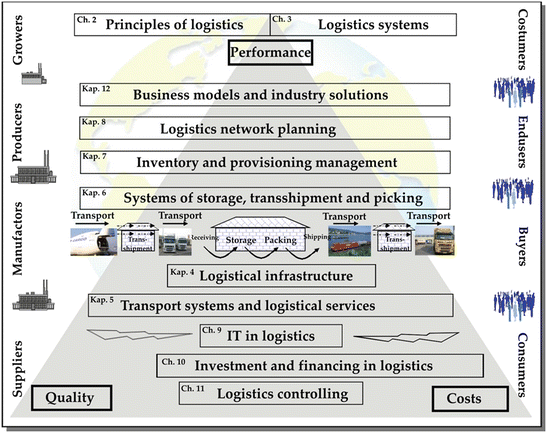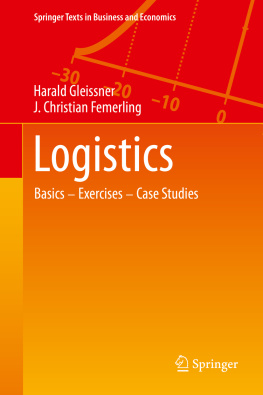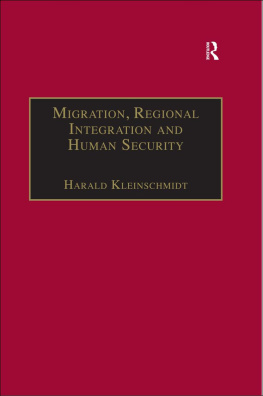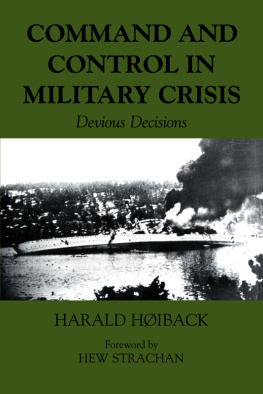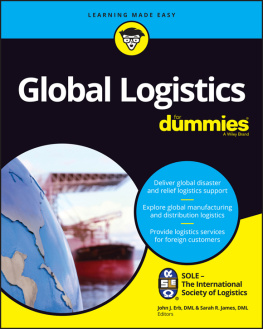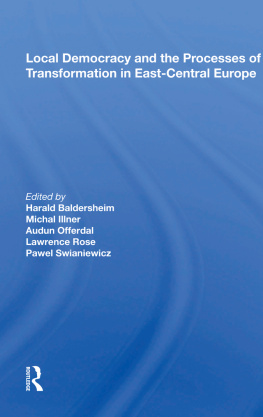Harald Gleissner and J. Christian Femerling Springer Texts in Business and Economics Logistics 2013 Basics Exercises Case Studies 10.1007/978-3-319-01769-3_1
Springer International Publishing Switzerland 2013
1. Introduction
Harald Gleissner 1 and J. Christian Femerling 2
(1)
Berlin School of Economics and Law, Berlin, Germany
(2)
Investa Holding GmbH, Eschborn, Germany
Abstract
The structure of this book is oriented towards the componential functions of logistics. The logistical task spectrum is characterized by a great degree of variety and dissimilarity. This is due firstly to logistics roles, functioning within both overall economic as well as business processes, in all value-added steps from the processing of raw materials to the enduser. The persons concerned with these valueadded steps are suppliers, manufacturers, producers, and service providers but even wholesalers and retailers whose goal is to satisfy the demands and wishes of their customers. Secondly, complexity arises due to dynamics that are simultaneously a result of business activities and promoted by logistics. In doing so, logistics finds itself constantly seeking a balance within the competing fields of performance, cost, and quality.
The structure of this book is oriented towards the componential functions of logistics. The logistical task spectrum is characterized by a great degree of variety and dissimilarity. This is due firstly to logistics roles, functioning within both overall economic as well as business processes, in all value-added steps from the processing of raw materials to the enduser. The persons concerned with these valueadded steps are suppliers, manufacturers, producers, and service providers but even wholesalers and retailers whose goal is to satisfy the demands and wishes of their customers. Secondly, complexity arises due to dynamics that are simultaneously a result of business activities and promoted by logistics. In doing so, logistics finds itself constantly seeking a balance within the competing fields of performance, cost, and quality.
Figure positions the individual topics addressed in this book into the broader context of the functions of logistics.
Fig. 1.1
Logistics and its branches
Chapter puts this basic knowledge into a topical context, thereby illustrating the broad range of application of logistics currently used in the economy. Both chapters are a prerequisite for the study of logistics; therefore, they are placed above the tripartite model of performance, cost, and quality.
As logistics needs its own specific infrastructure, Chap . presents logistical infrastructure facilities. In addition to the familiar traffic infra-and traffic suprastructure, this chapter also discusses other logistically significant facilities; namely, logistics real estate and structures of information and communication networks.
Chapter about inventory and provisioning management give a detailed account of the logistical core functions and therefore assume a central role in this book. They constitute the most essential body of knowledge for any future logistics expert.
Chapter deals with logistics network planning. In particular, basic decision-making processes and possible structures of warehousing networks and transportation networks are addressed.
Logistics systems have become inconceivable without the professional use of data processing. Thus, Chap . presents the most important and functionally necessary supporting instruments of information technology, identification technology, and communication technology.
Chapter introduces the reader to the topic of financing operations for stock, logistics real estate, and movable properties (equipment). This financial approach leads to an extended view on the supply chains including the monetary flows and generating the financial supply chain.
Controlling (used in the sense of managerial accounting) plays a pivotal role in the planning and monitoring of logistics systems. Chapter . All systems, facilities, and processes mentioned in the previous chapters assume the expenditure of capital.
In order to provide a context to the practice of logistics companies, Chap. presents the typical business models and industry solutions. Thus, the basic knowledge is brought into relation with applied logistics systems. At the same time, it illustrates the multi-faceted range of logistics solutions in practice.
Harald Gleissner and J. Christian Femerling Springer Texts in Business and Economics Logistics 2013 Basics Exercises Case Studies 10.1007/978-3-319-01769-3_2
Springer International Publishing Switzerland 2013
2. The Principles of Logistics
Harald Gleissner 1 and J. Christian Femerling 2
(1)
Berlin School of Economics and Law, Berlin, Germany
(2)
Investa Holding GmbH, Eschborn, Germany
Learning Objectives
As the field of logistics has undergone rapid developments both in scientific research and commercial practice, a multitude of new contents, point of views, and terminologies exists. The key aspects are explained in this chapter. The focus is on the development which has seen the transition of logistics from being perceived in a purely functional way to the modern view of management-oriented, holistic supply chain management. Subsequently, the individual levels of logistics, the involved agents, institutions and their key activities will be discussed. In this way, the readers are introduced to logistic actions and decisions, enabling them to identify with logistical issues by applying the most current understanding of logistics.
Keywords
Basic definitions of logistics Significance of logistics in the context of general business administration Classification and differentiation of logistics in the economic process The logistical system of performance with its components and key activities Agents and key elements of logistics in the national economic context Distinction between the terms procurement logistics, production logistics, and distribution logistics, and their basic decision fields Delivery policy as the basis for cost and price calculation
2.1 Definitions and Significance of Logistics
In a world which increasingly relies on the division of labor and fragmentation of work flows, goods and commodities need to be transported from their place of origin to their place of consumption or place of use. The span time between the production and the utilization of goods has to be bridged. This is also true for both the people and the information involved in the fragmented work flow and which are available in different locations and at different times within the system. The tasks and activities associated with this within the economic process were first systematically subsumed under the term logistics in mid-twentieth century. Initially, the term emerged in a military context since military systems are characterized by their tendency for concised classification.
The European Committee for Standardization CEN (Comit Europen Normalisation) defines logistics as:
the planning, execution and control
Of the movement and placement of people and/or goods and
Of the supporting activities related to such movement and placement, within an system organized to achieve specific objectives.
Here, the term system is to be understood as a dynamic unit of interconnected elements and subsystems, connected with each other in specific relations. These elements and subsystems form the system structure and by virtue of their interaction with each other result in the system behavior. The defining characteristic of a system is its orderliness.
